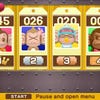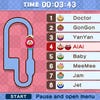Eurogamer Readers vs. Nintendo 3DS
Part 1: Richard Horne writes about his Amsterdam adventure.
Eventually developers will probably decide less is more, even when it comes to effective 3D visuals, and this is already clear in Nintendo's Pilotwings Resort, where your Mii sits in the middle distance, appearing to float and hover above the lush and colourful backgrounds. On my third play with the game I realise that with a deft tap of the Y button you can switch camera views from third-person to overhead to first-person, and the discovery is revelatory. Having only the one plane to focus on is exhilarating, and flying my aeroplane through rings, coves and the myriad obstacles on Wuhu Island is hugely impressive, especially when the 3D effects are subtle and sparing.
It appears the 3DS's touch-screen is resistive as opposed to the iPhone's, which is capacitive. Capacitive means that when your finger touches the screen it acts as a conductor, and results, according to Wikipedia, in "a distortion of the screen's electrostatic field, measurable as a change in capacitance". A resistive touch-screen features two layers that become connected when any physical object makes contact with the screen.
The use of a resistive touch-screen means I have to fight my natural inclination to use fingers instead of the stylus, because it is much less consistent. Whether this is a hardware or software limitation is unclear. It should be stated that the 3DS's touch-screen is as responsive, if not more so than the DS, but I want it to be as responsive as my iPhone.
Another thing that strikes me is that the 3DS seems to be a conflict of technologies. On the one hand you have the stunning 3D visuals, which really set the handheld apart from anything else out there, but then on the other – in what's surely hard evidence of Nintendo acknowledging the oft-denied threat of the iPhone – you have the gyroscopic sensors. When tilting the 3DS off its optimal angle ruins the 3D experience, what use is motion control? Does Nintendo really expect developers to use both technologies at the same time?
On the basis of SEGA's Super Monkey Ball 3D, I hope not. The 3DS version seems like a faithful, if not entirely predictable, interpretation of the many previous Monkey Ball games, and tasks you with navigating a minefield of obstacles by controlling the environment in order to tilt and roll your monkey-in-a-ball toward its objective. The game works exactly as you'd expect and looks great, but before starting you're given a choice between controlling the experience using the Circle Pad and the motion controls, and while the motion control is surprisingly responsive, I have to disable 3D to save myself from the inevitable headache.
Disabling motion control and using the Circle Pad is also an eye-opener, but this time a positive one. It's a considerable improvement on the directional pad. It's comfortable, responsive and applies just the right amount of resistance to allow for precise controls. It also makes a mockery of Sony's PSP nub, which could not be further apart ergonomically. Even for a game like Street Fighter IV 3D, which requires plenty of thumb gymnastics, it's a pleasure to use and I'm confidently unleashing Hadoukens and Shoryukens like the seasoned expert I wish I was.
Graphically the games on display are a mixed bunch. The 3DS is clearly more powerful than the original DS: its 3D worlds are rendered smoothly and beautifully with none of the artefacting that was prevalent in early DS games. But based on what I've played, it's hard to believe 3DS is as powerful as a PSP. But then while PSP games often appear unnaturally sharp and crisp, the 3DS' visuals are enhanced considerably by the added depth. And the fact that in-game models – even with low polygon counts – are so believably rendered adds another intangible layer of polish and sparkle that's hard to describe and quantify.
Referring back to back Ocarina of Time once again, while the models are quite primitive compared to modern games, the 3D effect somehow gives them a real sense of charm and personality. I immediately fall in love with the adolescent Link, pointy elbows and all, and now can't wait to play through this classic game all over again.
The Metal Gear Solid interactive demo also reinforces this. Watching Snake carefully sneak through a jungle environment is enchanting. At one point he hides beneath a tree root as an enemy soldier reaches through it to find his dropped cigarette box, and the soldier's hand appears to reach out of the screen. It's tense, dramatic and believable – and this is all the more remarkable because I am not actually playing the game, just controlling the camera. There's something about this level of immersion that ramps up tension, excitement and drama, creating a palpable anxiety I rarely experience in games, never mind handheld ones.
There are no doubt one or two hurdles the 3DS has to overcome, but it is clearly a device with a ton of untapped potential. History dictates that developers will take a few early missteps, and that a lot of the third-party launch games will be poorly executed and rushed to exploit early adopters (hi Ubisoft!). But when the 3DS works, it's a stunning proposition, and is yet another game-changer from Nintendo. Much as the Wii and DS disrupted the games industry, so too will the 3DS.
There's no doubt in my mind that it will sell by the bucket-load, and Nintendo is wise to include backwards compatibility. While the gaming community audibly groaned as the £229 price-point was mooted, I'd have no reservations recommending the 3DS at that price. This is one type of 3D that's not a fad or short-term curio; it's here to stay. Over to you Sony.





















